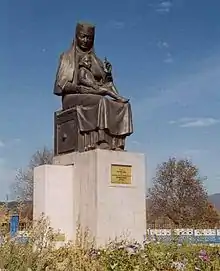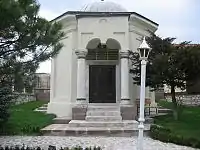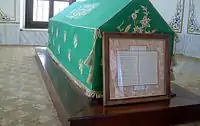Hayme Hatun
Hayme Hatun (Ottoman Turkish: حائمہ خاتون), also known as Hayma Ana[2] (Mother Hayma), was the grandmother of Osman I, founder of the Ottoman Empire and the mother of Ertuğrul Gazi, the leader of the Kayı clan of the Oghuz Turks.[3]She was from the tribe of dodurga located in Erzurum. Her brother was the bey of the tribe.
Hayme Hatun | |
|---|---|
حائمہ خاتون | |
 Statue of Hayme Ana and the infant Osman | |
| Died | |
| Burial place | Domaniç |
| Spouse(s) | Suleyman Shah[1] |
| Children | Ertuğrul Dündar Sungurtekin Gündoğdu |
Name
Her name appears as Haymana, Hayme Hatun, Hayme Sultan, Ayva Ana and Ayvana. The name Hayma Ana seems to be an obvious transference of the topographic term haymana, or "prairie", into a personal name.
Burial place


Hayma Ana's last resting place is at Çarşamba, a village near Domaniç, in a pasture area, close to a route connecting the lowlands east of Bursa with Tavşanlı. In 1892 Abdul Hamid II saw the recovery of the tomb of Hayme Ana.[4]
Family
She was of Turkish descent and the belonged to a Turkmen family. She was the grandmother of Osman I, the founder of the Ottoman Empire. She had four sons:
- Ertuğrul Gazi (father of Osman I), Bey of Söğüt
- Dündar Bey
- Gündoğdu Bey
- Sungurtekin Bey
See also
- Ottoman family tree (more detailed)
- Ottoman Empire
- Ottoman dynasty
- Halime Hatun
Further reading
- İsmail Hakkı Uzunçarşılı, Osmanlı Tarihi, C.I
- Selim Yıldız, “Hayme Ana”, Vilayetlerin Sultanlığından Faziletlerin Sultanlığına Osmanlı Devleti, Kütahya 1999, s.40
- Mehmed Maksudoğlu, Osmanlı Tarihi, İstanbul 2001, s.21
References
- İnalcık, Halil (2007). Osmanlı Beyliği'nin Kurucusu Osman Beg. Belleten (in Turkish). Ankara. pp. 487–490.
- Sakaoğlu, Necdet (2008). Bu mülkün kadın sultanları: Vâlide sultanlar, hâtunlar, hasekiler, kadınefendiler, sultanefendiler (in Turkish). Oğlak Yayıncılık. pp. 25–27. ISBN 978-9-753-29623-6..
- Akgunduz, Ahmed; Ozturk, Said (2011). Ottoman History - Misperceptions and Truths. IUR Press. p. 35. ISBN 978-90-90-26108-9. Retrieved 31 July 2020.
- Sakaoğlu, Necdet (2008). Bu mülkün kadın sultanları: Vâlide sultanlar, hâtunlar, hasekiler, kadınefendiler, sultanefendiler (in Turkish). Oğlak Yayıncılık. p. 26. ISBN 978-9-753-29623-6.